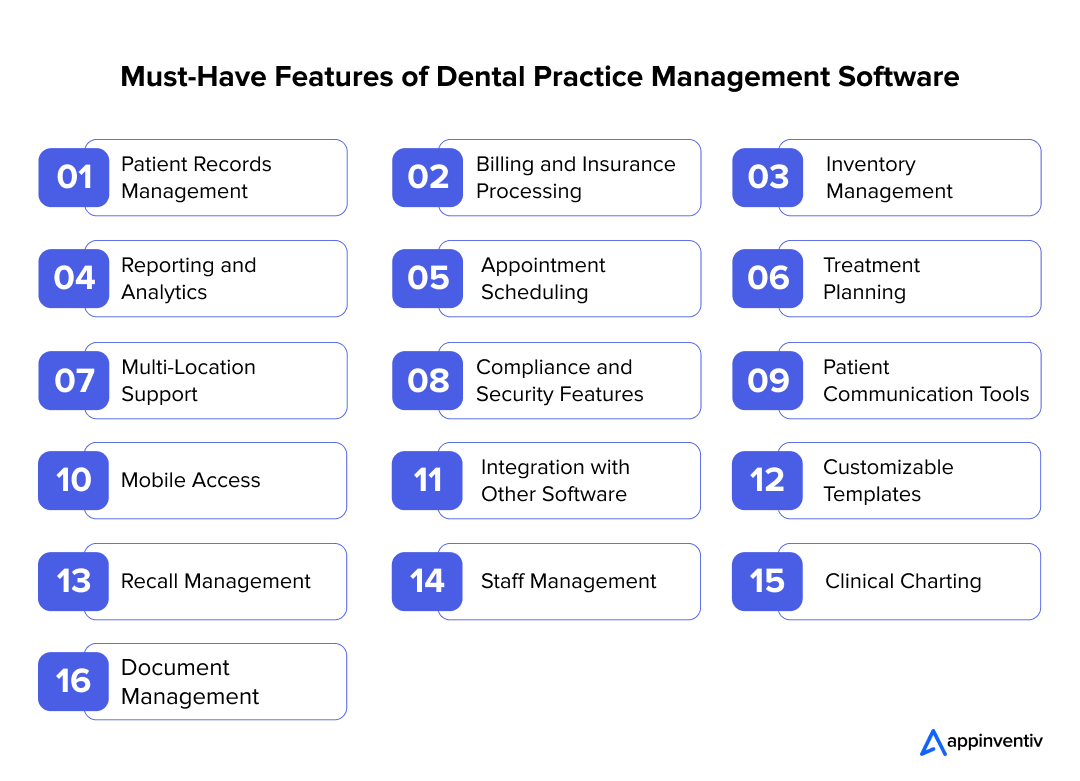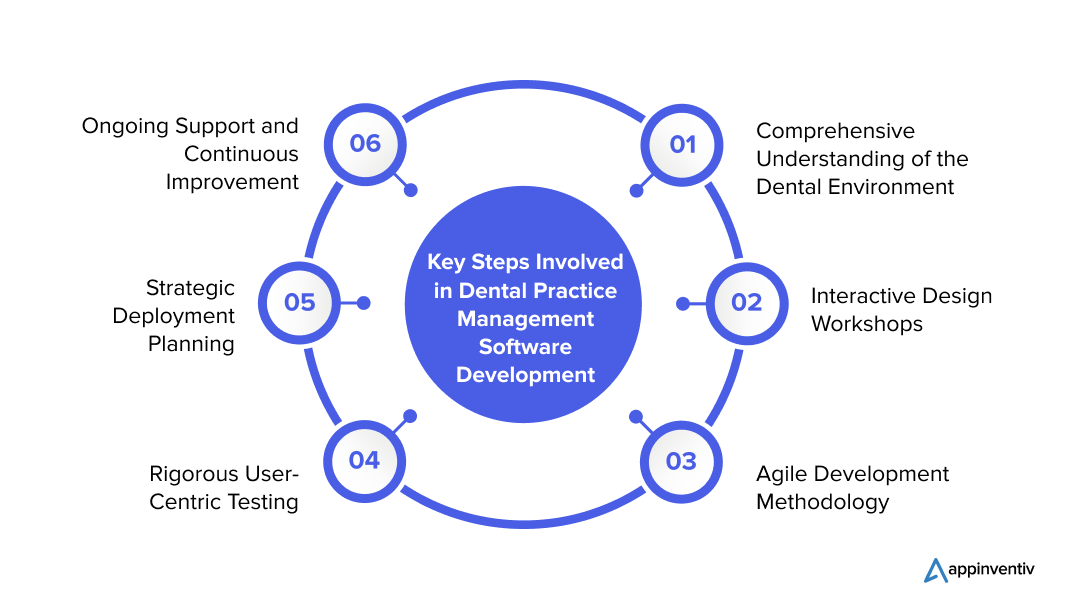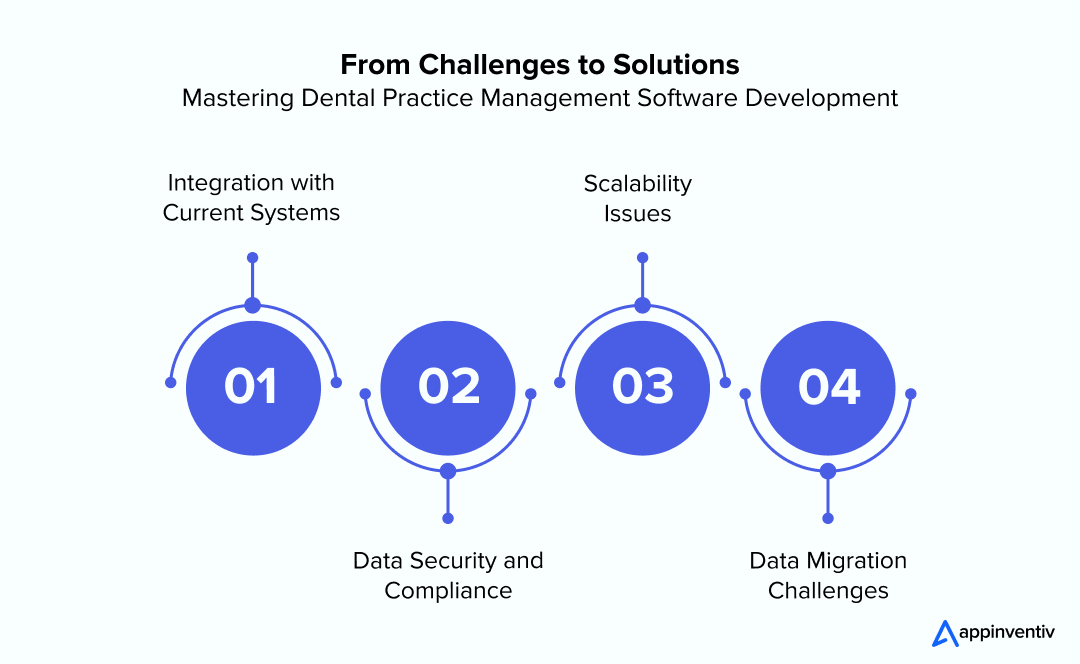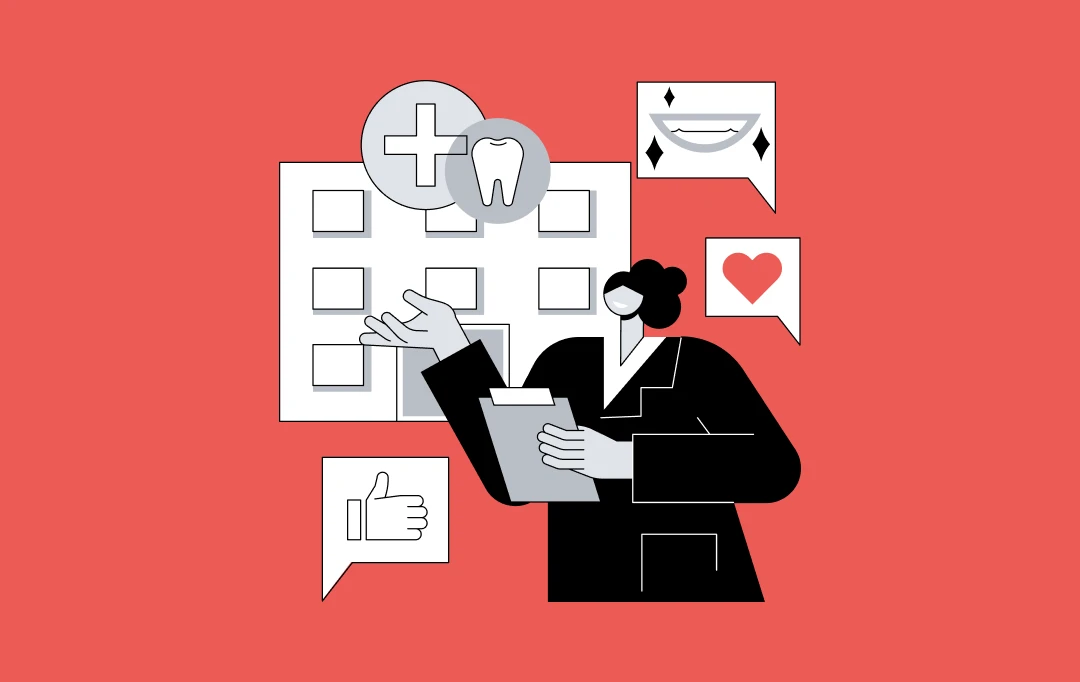- Dental Practice Management: An Overview of Market Trends and Recent Innovations
- Essential Types of Dental Software for Modern Practices
- Telehealth Dental Software
- Dental Laboratory Management Software
- Orthodontic Practice Management Software
- Dental Scheduling Software
- Dental Imaging Software
- Cloud-Based Dental Software
- Dental Records Software
- Navigating the Key Features of Dental Practice Management Software
- Factors Affecting the Overall Dental Practice Management Software Development Cost
- Integration with Existing Systems
- Technology Stack Selection
- Complexity of Features
- User Interface and User Experience Design
- Size of Dental Software Development Team
- Geographical Location of the Development Team
- Future-Proofing and Updates
- Dental Practice Management Software Development Process
- Comprehensive Understanding of the Dental Environment
- Interactive Design Workshops
- Agile Development Methodology
- Rigorous User-Centric Testing
- Strategic Deployment Planning
- Ongoing Support and Continuous Improvement
- Challenges in Custom Dental Practice Management Software Development and Solutions to Overcome Those
- Integration with Current Systems
- Data Security and Compliance
- Scalability Issues
- Data Migration Challenges
- Hire Appinventiv for Your Dental Practice Management Software Needs
- FAQs
In recent years, dental practices have shifted away from manual, paper-based systems and embraced advanced software solutions. This change boosts efficiency, enhances patient experiences, and improves data management.
While dealing with patient data, dentistry has ditched old-school methods like physical charts, appointment books, and manual billing. They’ve leveled up with a high-tech data handling & analysis approach that’s way more efficient and cuts down on mistakes quickly.
According to the American Dental Association (ADA), the number of dentists is projected to grow significantly, with an estimated 67 dentists for every 100,000 people by 2040.
As the dental industry evolves, adopting software solutions has become crucial for staying competitive, meeting regulatory standards, and improving overall efficiency. Features like electronic health records (EHR), appointment reminders, and automated billing simplify patient interactions and administrative tasks, saving time and enabling better data analysis.
These software make it much easier for dentists to handle patient interactions and administrative tasks. This digital transformation saves time and allows for better data analysis, helping practices make informed decisions that enhance dental care.
Despite the benefits, stakeholders often grapple with the cost to develop dental practice management software. These costs can range from $40,000 to $300,000 or more, depending on various factors.
In this blog, we will explore the key factors influencing the cost of dental practice management software development, along with a market overview, types of dental software, essential features, the development process, and implementation challenges. Let’s dive in for a closer look.
Dental Practice Management: An Overview of Market Trends and Recent Innovations
As reported by Grand View Research, the global dental practice management software market is projected to reach a valuation of $5.0 billion by 2030, growing at a CAGR of 10.17% from 2024 to 2030. The market growth is driven by several key factors, including the rising adoption of healthcare IT solutions in specialty clinics like oral practices, which is expected to improve insurance coverage. As more people seek dental services, the demand for effective dental practice management (DPM) software will also increase.

The dental practice management software market is seeing an increasing level of innovation, with many companies introducing new products to enhance their presence. Additionally, supportive government policies and regulations focused on data safety and the effectiveness of DPM software are likely to contribute to further growth. Together, these trends create a promising landscape for investing in DPM solutions, helping dental practices become more efficient and competitive.
In January 2024, Smilefy, Inc. launched Smilefy 4.0, an AI-powered 3D smile design software that enables dental professionals to create detailed 3D models and allow patients to preview their new smiles, enhancing communication and setting realistic expectations.
In 2023, Ora introduced an innovative “all-in-one” practice management software tailored for dental practices, integrating tools for a seamless experience with a single platform, support team, login, and billing system. Meanwhile, Patient Prism and Curve Dental are collaborating to accelerate growth in dental practices nationwide, promoting digital and AI transformation.
These advancements and market growth illustrate the ongoing evolution in the dental industry, highlighting the critical need for investment in effective dental management software to enhance competitiveness and patient care.
Essential Types of Dental Software for Modern Practices
From practice management systems to specialized tools for billing and imaging, understanding the essential types of dental software can help practices choose the right solutions to meet their unique needs. Here’s a look at the key software types that modern dental practices should consider.

Telehealth Dental Software
Telehealth software makes it easy for dental professionals to hold remote consultations and follow-ups with patients through video calls. This is particularly useful for individuals living in remote areas, as it makes dental care much more accessible.
Developing telehealth software can range from $30,000 to $150,000.
Dental Laboratory Management Software
This software is designed specifically for dental laboratories, helping to streamline workflows, track orders, and improve communication between dental offices and labs.
The development cost for dental laboratory management software typically ranges from $30,000 to $100,000.
Orthodontic Practice Management Software
Created for orthodontic practices, this software features tools for tracking treatment progress, communicating with patients, and visualizing 3D treatment plans.
Creating orthodontic practice management software can cost between $25,000 and $150,000.
Dental Scheduling Software
Dental scheduling software simplifies appointment management, allowing dentists to efficiently organize patient appointments and treatment planning.
The overall dental appointment scheduling software development usually ranges from $30,000 to $100,000.

Dental Imaging Software
This software focuses on capturing, storing, and analyzing dental images such as 3D scans and X-rays. It enhances diagnostic capabilities by allowing dentists to view and manipulate images for better treatment planning.
The dental imaging software development cost typically ranges from $30,000 to $200,000.
Cloud-Based Dental Software
Cloud-based dental software is hosted on remote servers and accessed via the internet, making it a flexible solution for modern dental practices. This model allows users to access their systems from anywhere with a fast internet connection, reducing on-site hardware requirements and IT maintenance.
Creating cloud-based dental software can cost between $20,000 and $150,000.
Also Read: Remote Patient Monitoring Software Development Cost
Dental Records Software
Dental records software manages and organizes both clinical and administrative information related to patients. It encompasses medical demographics, appointment schedules, treatment plans, digital X-rays, and insurance details.
The development cost for dental records software usually falls between $20,000 and $100,000.
Navigating the Key Features of Dental Practice Management Software
Dental practice management software includes extensive features that simplify operations and enhance patient care. However, it is essential to note that implementing a few advanced features might impact the overall cost to develop dental practice management software. Here’s an overview of the essential features that can transform how dental practices manage their workflows.

1. Patient Records Management: Allows patients to access all files in one place, including medical histories and treatment notes.
2. Billing and Insurance Processing: Streamlines workflows and simplifies insurance claims with options to integrate various providers.
3. Inventory Management: Track the inventory of your dental supplies and equipment and get automatic alerts when stock is running low.
4. Reporting and Analytics: Get insights into your practice’s performance with reports and metrics that help you understand growth and enhance profitability.
5. Appointment Scheduling: Easily book and reschedule appointments, and enjoy the convenience of automated reminders sent via email or text.
6. Treatment Planning: Create detailed treatment plans with helpful visual aids that make explaining procedures to your patients easier.
7. Multi-Location Support: Facilitates management of practices with multiple locations, allowing centralized data oversight and coordination.
8. Compliance and Security Features: Ensures HIPAA compliance with patient data protection, secure logins, and staff user role management.
9. Patient Communication Tools: Enables secure messaging between staff and patients, along with automated educational materials and follow-up reminders.
10. Mobile Access: Provides mobile-friendly interfaces or dedicated apps for practitioners to manage tasks and access information on the go.
11. Integration with Other Software: Supports compatibility with imaging software, lab systems, and accounting tools for seamless data transfer.
12. Customizable Templates: Allows the creation and modification of treatment and billing templates to meet specific practice needs.
13. Recall Management: Automates reminders for routine check-ups and treatments, helping you stay on top of patient follow-ups and boost retention.
14. Staff Management: Streamlines human resources with scheduling tools for staff shifts, performance tracking, and payroll management, making it easier to manage your team.
15. Clinical Charting: Offers tools for thorough clinical documentation, with customizable charts and diagrams for different dental procedures.
16. Document Management: Keeps all your important documents like consent forms, treatment agreements, and educational materials organized and easily accessible in one central location.
Factors Affecting the Overall Dental Practice Management Software Development Cost
The cost to develop dental practice management software can vary widely based on different influencing factors. From the complexity of dental software features and functionalities to the choice of technology and development team, understanding these factors is crucial for effective budgeting. Here’s a closer look at the key factors that impact the overall development cost.

Integration with Existing Systems
Integrating dental software with existing systems, such as electronic health records (EHR) or dental billing software development, can add considerable expense to the project. However, this integration is essential. The complexity of these integrations varies, as it involves data migration, ensuring compatibility, and possibly redesigning certain functionalities.
The time required for testing and troubleshooting these integrations can also extend the development timeline, further impacting the cost to develop dental practice management software. Proper planning is essential to manage these integration challenges effectively.
Technology Stack Selection
The selection of the technology stack, encompassing frameworks, programming languages, and tools, can significantly influence the dental practice management software development costs. Certain technologies may incur higher licensing fees or demand specialized skills that can be costly to acquire.
It’s essential to weigh the benefits of adopting cutting-edge technologies against their cost-effectiveness, ensuring that the chosen stack aligns with project goals. The thoughtful selection of the tech stack lays the groundwork for a scalable solution.
Complexity of Features
The complexity of the features you choose to include will significantly affect the overall cost to develop dental practice management software. Basic functionalities such as appointment scheduling and patient billing are generally less expensive to implement. In contrast, advanced features like patient analytics, telehealth capabilities, and custom reporting require more development time and specialized expertise.
Each added layer of complexity not only increases the development time but may also necessitate additional resources, leading to higher dental practice management software development costs.
User Interface and User Experience Design
Investing in high-quality UI and UX design is crucial for ensuring user adoption and satisfaction. A well-crafted design enhances usability and accessibility, which is particularly important in a fast-paced dental environment.
This process requires time, research, and expertise, which can increase the cost to develop dental practice management software. Additionally, incorporating user feedback through iterative testing will contribute to refining the design, ensuring that the final product meets user expectations and workflow requirements.
Size of Dental Software Development Team
The size of your development team plays a crucial role in influencing overall costs. A larger team can enhance productivity by distributing tasks effectively, but it may also lead to higher salaries and overhead expenses. Conversely, a smaller team may be more cost-efficient but could prolong project timelines.
An effective dental software development team typically includes a Project Manager, Business Analyst, UI/UX Designer, Front-End and Back-End Developers, Quality Assurance Specialist, Security Specialist, Technical Support Specialist, and DevOps Engineer, ensuring that all aspects of the dental software development project are comprehensively covered. Finding the right balance between team size, complexity, and costs is essential for success.
Also Read: How to hire a dedicated development team?
Geographical Location of the Development Team
The geographical location of your development team significantly impacts costs and the overall success of your project. Hiring from India offers access to a vast talent pool featuring skilled professionals in software development, UI/UX design, and quality assurance, often at competitive rates.
Teams located in regions with high living costs, like North America and Western Europe, typically charge higher hourly rates, which can affect the overall cost to develop dental practice management software. In contrast, teams from Asian countries such as India provide access to a large talent pool, making India an appealing choice for companies seeking quality dental software development services.
Future-Proofing and Updates
Planning for future-proofing the software can influence initial costs significantly. Investing in adaptable architecture that allows for easy updates and integration of new technologies or features may require a higher upfront cost to develop dental practice management software. However, this strategic investment can reduce long-term maintenance and upgrade expenses, making it a worthwhile consideration for dental practices looking to sustain their software over time.
Additionally, a future-proof design can enhance the software’s scalability, enabling practices to evolve alongside technological advancements and changing industry needs, thereby maximizing return on investment. This foresight ensures that the software remains relevant in the competitive digital landscape.
Dental Practice Management Software Development Process
By adhering to the essential steps in developing dental practice management software, businesses can ensure the solution is tailored to their requirements and integrates smoothly with existing systems. Let’s explore the major stages involved in this dental practice management software development process.

Comprehensive Understanding of the Dental Environment
As a dental software developer, your initial focus should be understanding dental practices’ unique challenges. You can identify inefficiencies and specific needs by conducting interviews, observing interactions, and utilizing surveys.
This foundational knowledge is essential for crafting software that enhances operational efficiency and improves patient care, ensuring that your solution aligns seamlessly with the realities of their daily work.
Interactive Design Workshops
You should prioritize collaboration by organizing interactive design workshops with dental teams. These sessions unite developers and end-users in brainstorming and visualizing the software together. You can gather critical input and iterate on design concepts by facilitating these discussions and utilizing mockups in real-time.
This collaborative approach drives a sense of ownership among users and ensures that the final product delivers an intuitive user experience that meets their practical needs.
Agile Development Methodology
Adopting an agile development methodology enables you to maintain responsiveness and flexibility throughout the project lifecycle. You can focus on delivering features incrementally by breaking the development process into manageable sprints.
This allows you to gather continuous feedback from dental professionals and make necessary adjustments based on their insights. Regular check-ins help you remain aligned with user needs and pivot effectively when new information arises, resulting in a more effective and user-friendly software solution.
Rigorous User-Centric Testing
Recognizing that testing goes beyond mere bug identification, you understand the importance of ensuring that the software integrates seamlessly into the daily operations of dental practices. Engage real users during testing phases, allowing them to navigate the software in a controlled environment.
Their feedback will be invaluable in refining usability, addressing potential challenges, and enhancing the overall user experience. By prioritizing user-centric testing, you ensure that the final product is not only functional but also meets the everyday expectations of its users.
Strategic Deployment Planning
Developing strategic plans tailored to each practice’s unique requirements is essential when preparing for deployment. This may involve a phased approach, introducing key features incrementally to help staff seamlessly adapt to the new system.
By prioritizing the minimization of disruptions to daily operations and implementing robust backup systems, you can ensure a seamless transition to the new software. This approach fosters user confidence and encourages acceptance during the changeover.
Ongoing Support and Continuous Improvement
Post-launch, your commitment to the practice should extend into ongoing support and open communication channels. Encourage dental practices to report issues or suggest enhancements, creating a collaborative atmosphere for continuous improvement.
By actively monitoring software performance and soliciting user feedback, you can implement updates and new features that evolve in tandem with the practice’s needs, ensuring that your solution remains relevant, effective, and invaluable over time.
Challenges in Custom Dental Practice Management Software Development and Solutions to Overcome Those
Dental practice management software development comes with a series of challenges. However, these challenges can be resolved easily with unique solutions. Let’s have a look at those.

Integration with Current Systems
There can be substantial technical difficulties when integrating new software with current systems. Compatibility problems could occur and cause inefficiencies and data silos.
Solution: Use a modular development strategy to make integration simpler. Use well-defined APIs to facilitate communication across systems. Before full implementation, pilot testing should be done to find possible integration issues and ensure all systems are in sync.
Data Security and Compliance
It’s imperative to safeguard private patient data while adhering to laws like HIPAA. If you don’t, there might be serious financial and legal consequences.
Solution: Put strong security measures in place. These should include frequent security audits, secure user authentication, and data encryption. Keep abreast of compliance standards by working with IT and legal specialists to build essential features right from the start. Provide all employees with frequent training on data security best practices.
Scalability Issues
Custom software that is not designed with scalability in mind can struggle to keep up with the growing needs of a dental practice, leading to slow performance and potential downtime.
Solution: Plan for scalability by designing a flexible architecture that allows easy upgrades and adding new features as the practice grows. Conduct performance testing to ensure the software can handle increased workloads and user demands. Consider cloud-based dental practice management software development that can easily scale with practice needs.
Data Migration Challenges
Transitioning data from legacy systems to new software can be complex and risky, with the potential for data loss or corruption during the migration process.
Solution: Plan a comprehensive data migration strategy that includes data mapping, validation checks, and backup procedures. Conduct a pilot migration with a subset of data to identify issues before a full-scale migration, ensuring that data integrity is maintained.
Hire Appinventiv for Your Dental Practice Management Software Needs
The future of dental software is poised for transformation, driven by technological advancements and evolving patient expectations. As dental practices increasingly adopt cloud-based solutions, integrate telehealth capabilities, and leverage AI-driven analytics, the focus will shift toward enhancing patient engagement and streamlining workflows. Innovations like gamification and interoperability with healthcare systems will empower dental professionals to deliver personalized care more efficiently.
With a strong portfolio, including various healthcare projects like YouCOMM, Health-e-People, Soniphi, and DiabeticU, Appinventiv is well-equipped to create impactful software solutions that drive efficiency and improve patient care.
Appinventiv, a trusted healthcare app development company, leads the way in building robust dental practice management software tailored to your needs.
1. In-Depth Healthcare Knowledge: Leveraging extensive expertise in healthcare technology, Appinventiv enhances practice efficiency and elevates patient experiences through cutting-edge solutions.
2. Patient-Centric Focus: Our experts strongly emphasize patient engagement, ensuring that the custom-built software effectively addresses the needs of both healthcare providers and patients.
3. Adaptive Development Process: Utilizing an agile development approach, we quickly respond to changing requirements, ensuring flexibility and responsiveness throughout the project.
If you are interested to learn more about the cost to develop dental practice management software, connect with our experts today. We’re here to guide you through the process and help you bring your vision to life!
FAQs
Q. Why is dental practice management software important?
A. Dental practice management software is essential for optimizing operations, improving patient care, and increasing efficiency. It simplifies appointment scheduling, billing, and patient record management, reducing administrative tasks and errors.
This software enhances patient communication through reminders and follow-ups, improving retention rates. Furthermore, it offers valuable analytics and reporting tools that help practices recognize trends and enhance performance, leading to a more organized and profitable dental office.
Q. How long does it take to build a custom dental practice management software?
A. Creating custom dental practice management software usually takes about six months to a year, depending on the complexity of the project and the specific features needed. This development timeframe includes stages like consultation, design, development, testing, and finally, launching the software.
Factors such as the number of features, integration with existing systems, and user feedback can all affect the development timeline. Good planning and open communication between developers and dental businesses are key to keeping the project on schedule and tailored to the practice’s needs.
Q. What are some of the top benefits of dental practice management software development?
A. Here are some of the major benefits of dental practice management software development:
- Enhances Patient Experience: Features like online booking and automated reminders increase patient satisfaction.
- Improves Communication: Facilitates easy communication among staff, patients, and specialists for better care coordination.
- Offers Scalability: Grows with the practice, accommodating more patients and services as needed.
- Allows Customization: Tailors features and workflows to fit the practice’s specific needs.
- Streamlines Billing: Automates billing and insurance processes, reducing errors and speeding up payments.
- Provides Insights: Analytics and reporting tools help practices understand performance metrics for informed decision-making.
Q. What are some top trends in dental practice management software development?
A. Some of the top important trends in dental dental practice management software development include:
- Robotic Process Automation (RPA): RPA automates repetitive tasks like scheduling and billing, increasing efficiency and allowing staff to focus on patient care.
- Gamification: Gamification elements motivate patients and staff, making dental care more engaging and enjoyable.
- Health Information Exchange (HIE): HIE facilitates secure patient data sharing among providers, improving care coordination and patient safety.
- Telehealth Integration: Remote consultations are now enabled through telehealth features for virtual appointments and follow-ups.
- Cloud-Based Solutions: Cloud-based dental software development is increasingly being adopted and preferred by dental organizations for flexibility and ease of access from any location.



EMR Integration in Healthcare Systems - Benefits, Features, Process, Costs
EMR integration, having proved its worth in the healthcare space with improved workflows, better patient engagements, and lowered operational costs has built itself a projected market share of USD 20.7 billion. Eventhough a range of hospitals swear upon the benefits EMR system integration has garnered them, the adoption level digital healthcare industry anticipated has still…

Healthcare Data Warehousing Benefits and Use Cases - Centralizing Data for Improved Patient Care
The healthcare industry is one of the sectors that generates a massive amount of data, accounting for approximately 30% of the world's data volume. This value is set to increase, indicating the urgency of healthcare data warehousing. Data warehousing is an important component of enterprise data management strategy. It is a necessary analytical tool used…











